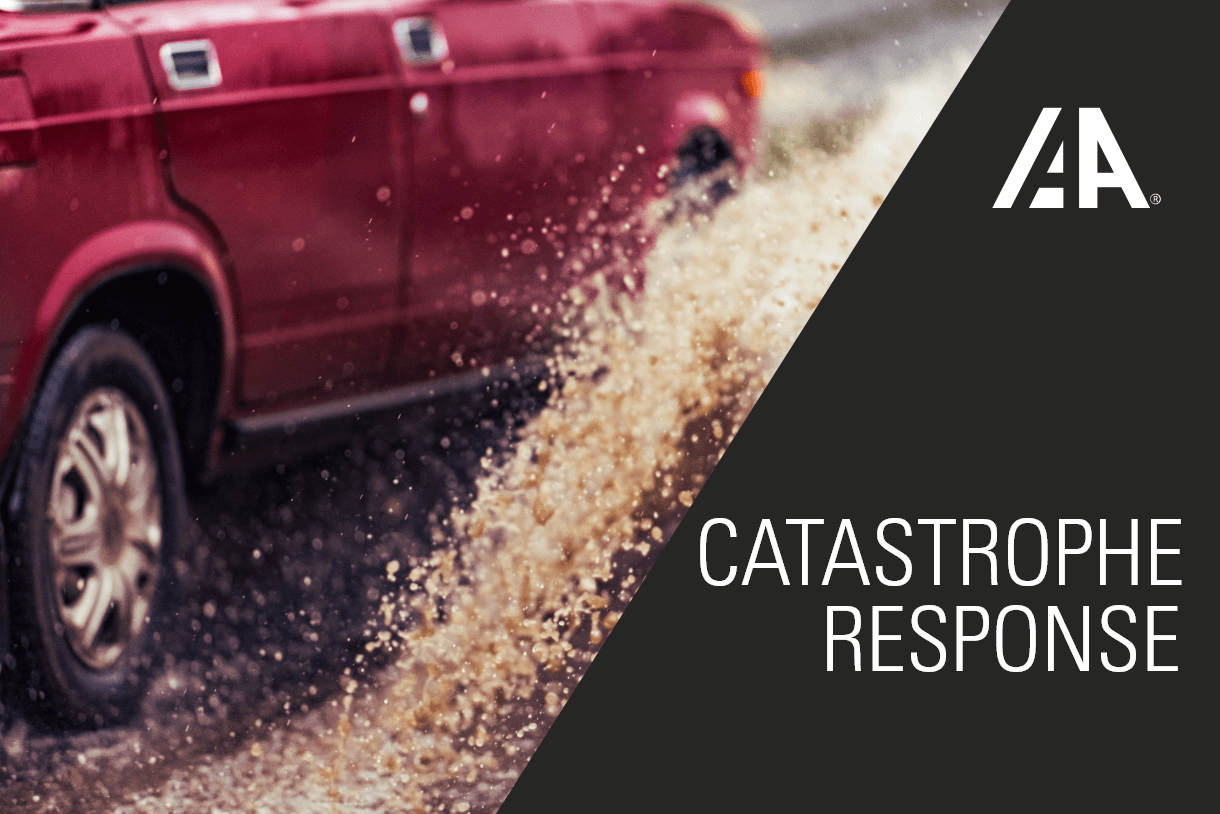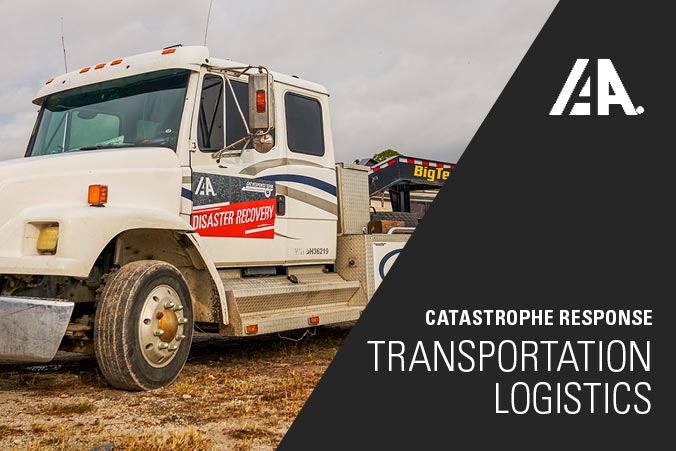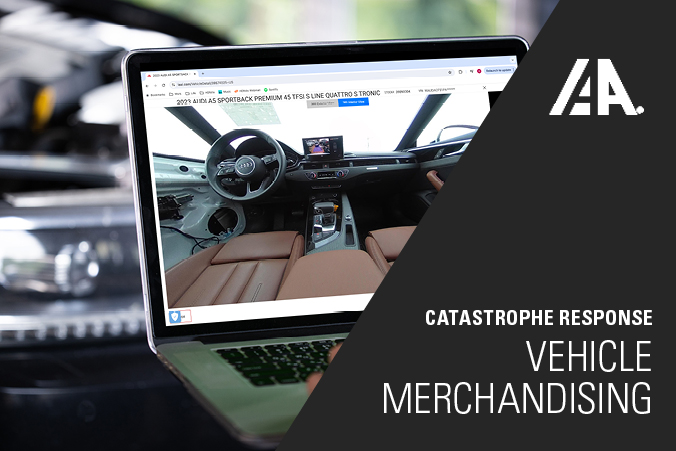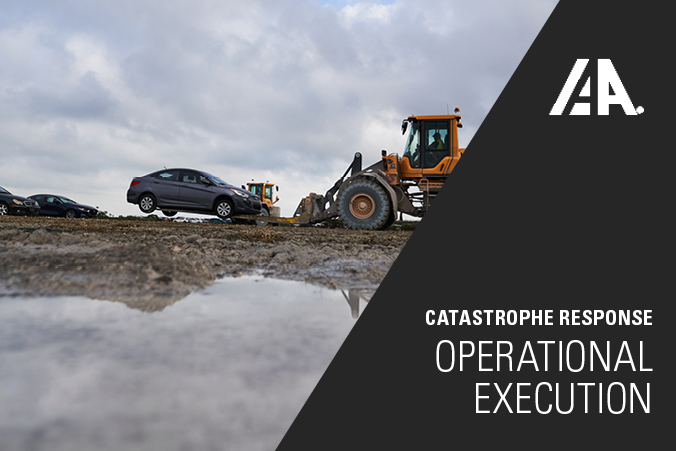Catastrophe Response
IAA's Catastrophe Response Strategy Brief: Transportation Logistics
Published August 6, 2020 - Written by IAA, Inc.
8 Min read
Summary
IAA looks at their transportation logistics, one of the key components that make up our catastrophe response strategy.
This brief was updated on July 7, 2022
Overview
Every weather catastrophe is dynamic and different. Timing, intensity, landfall location and population are just a few factors that determine the overall result of a catastrophe. Because weather events, such as hurricanes, have many constantly shifting variables, any response process has to be proactive yet flexible to ensure a timely and appropriate response.
IAA’s Catastrophe Response Strategy provides an unmatched level of service to our customers in their greatest time of need. Over the last 40 years, IAA has invested significant research and resources in developing its industry-leading catastrophe response discipline. It comprises four key areas: Real Estate Capacity, Operational Execution, Transportation Logistics and Vehicle Merchandising. We employ a continuous improvement methodology to ensure our Catastrophe Response Strategy remains superior in the market.
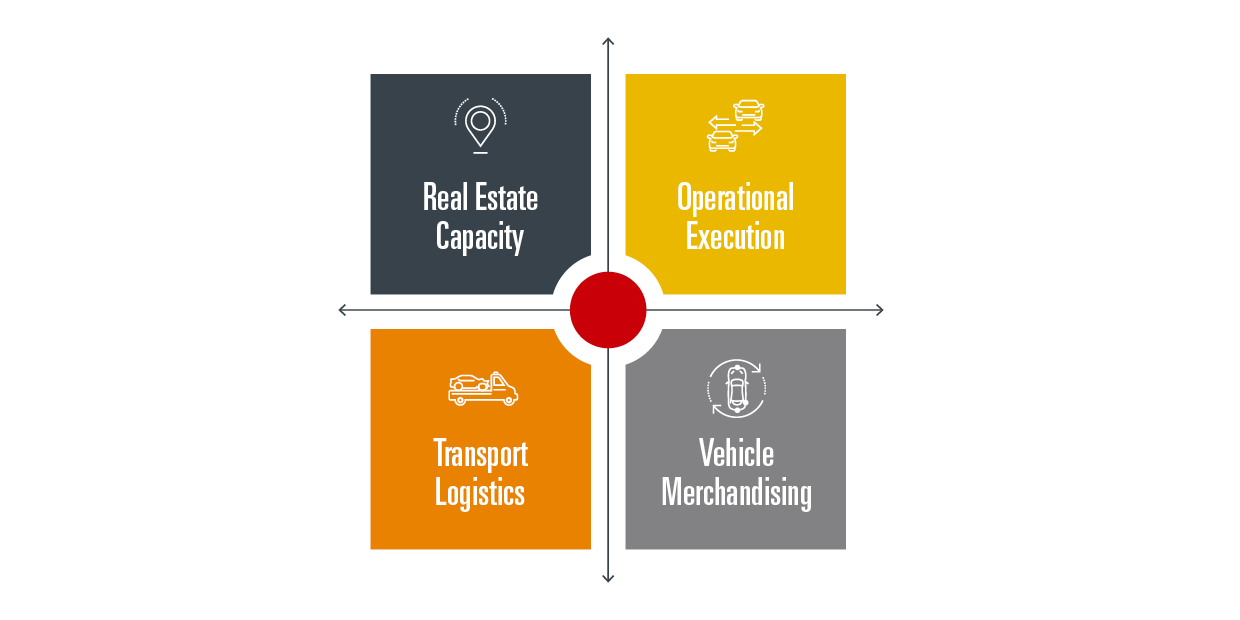
Transportation Logistics
The most significant challenges when planning to retrieve thousands of vehicles impacted by a catastrophic weather event are the unknowns. What level of towing resources are needed to respond effectively? Beyond the simple execution of moving a large number of vehicles quickly and efficiently after a storm, a Transportation Logistics Strategy must start with an effective capability to forecast demand, and translate that into a quantifiable amount of resources. Securing the right resources is the only way to meet the needs and concerns of providers, their policyholder customers, and IAA’s own tower network.
IAA addresses these transportation and logistics challenges with industry-leading innovation, preparation and execution. Decades of catastrophe-specific data allow IAA to forecast the demand for towing resources based on various event types. Our demand models help secure the right resources and deploy them to the right location, at the right time. This results in a highly efficient towing operation that reduces cycle times, increases response reliability and efficiency, and allows providers to better manage increased claim volumes. It also provides towers with an efficient, seamless and productive experience.
IAA’s primary commitment is to transport customer’s vehicle assets quickly and efficiently to our facilities. This is particularly important during catastrophic events when impacted vehicle volumes can dramatically surge. By digitizing and automating a historically cumbersome, paper-driven assignment process, our towing partners maintain productivity, and can seamlessly manage their assignments, routes and loads.
IAA’s preparation around Transportation Logistics focuses on four key areas:
- Initial Response Capability
- Nationwide Towing Network
- Logistics Technology
- Scalable Release Process Administration
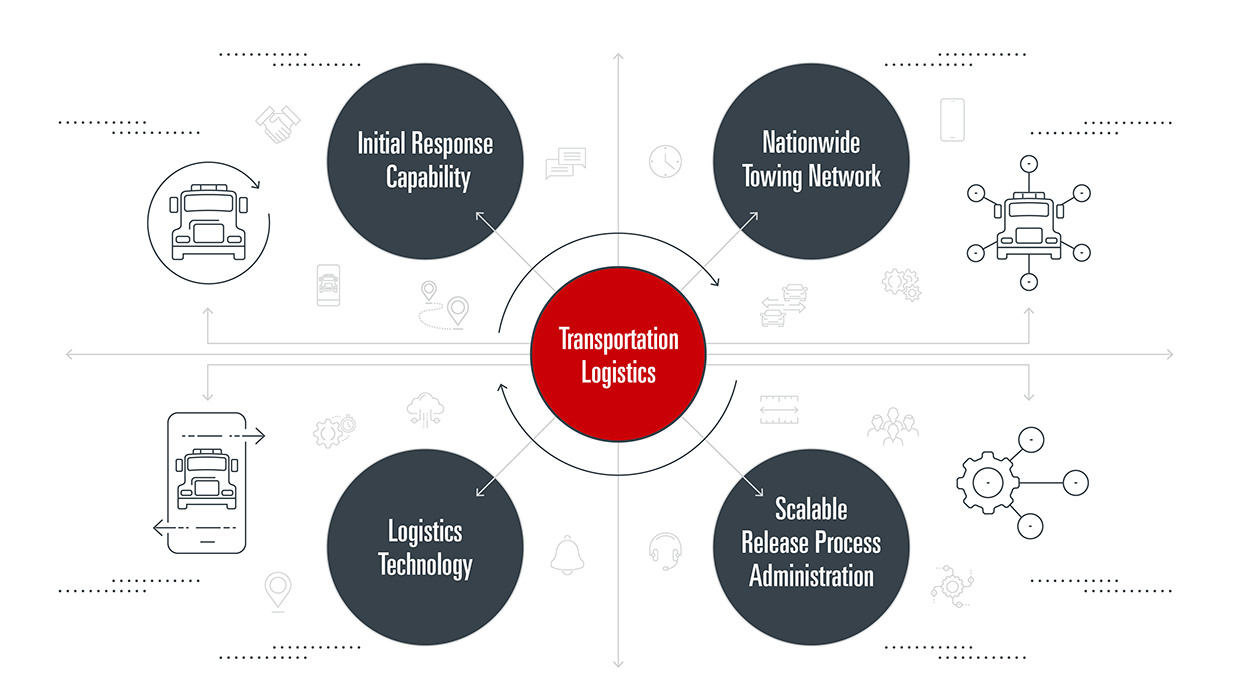
Initial Response Capability
IAA developed our Initial Response tower network to ensure transportation service immediately after the storm has passed. Our Initial Response tower network includes a broad network of trucks that understand the urgency of getting to the affected area quickly.
In addition to the Initial Response tower network capability, IAA’s nationwide tower network provides the capacity and flexibility to effectively manage an influx of vehicles after a catastrophic event, regardless of where it occurs. We accomplish this by continuously investing in our tower network and fostering strong relationships with our towing providers.
A key component in building those relationships is our partnership approach, built around the logistics principle of on-time performance. Each IAA towing partner is fully contracted with IAA and agrees to service level and delivery standards. All vehicles moving through the IAA logistics system include a delivery expectation, and our towers are evaluated according to their delivery performance. In addition, our entire tower network utilizes our logistics technology, including the Auto Dispatch feature from the IAA Tow App™, to provide a seamless, efficient, productive experience for towers.
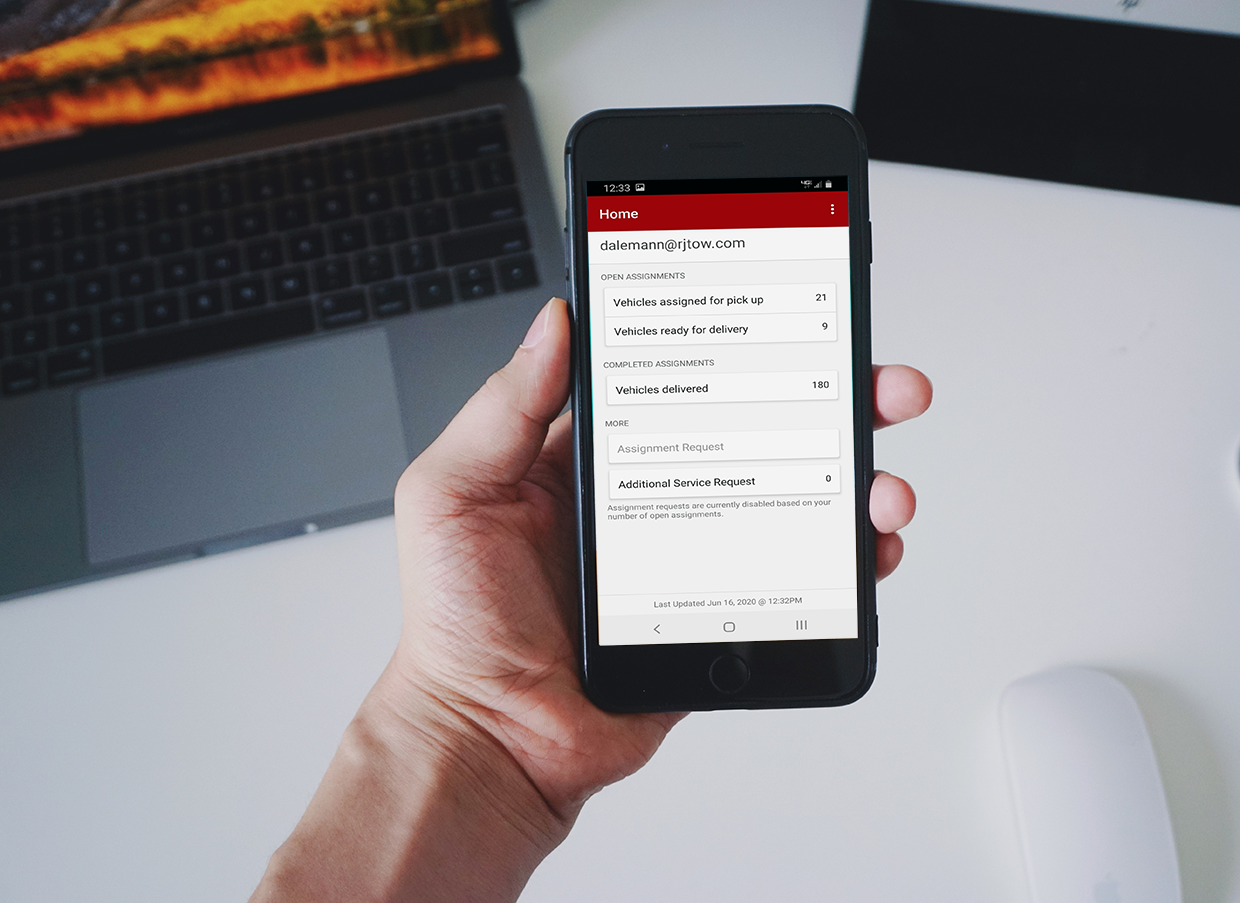
IAA actively works to provide towers with significant financial and operational benefits, including:
- Density to fill out truck capacities
- In-bound and outbound tow assignments for increased efficiency
- Wait-free, automated dispatching
- Paperless and seamless processes
- Real-time data on vehicles, drop-off times, locations, and log notes
Nationwide Towing Network
IAA views Transportation Logistics within our business model in two facets – day-to-day operations and catastrophe. When a catastrophic event occurs, focus increases in the affected area, however operations and on-time performance must continue across all our over 210 facilities. To continue seamless day-to-day operations, we maintain a separate network of towers for catastrophe response.
We are continually building relationships within the towing industry to provide the resources needed to manage the transport needs arising from any size catastrophe event. This partner relationship approach increases the reliability of IAA’s towing resources, a competitive advantage beyond simply owning tow trucks.

One of the most critical issues in Transportation Logistics is balancing day-to-day transport needs with catastrophe assistance. Company-owned towing assets support day-to-day operations. When a catastrophe happens and those assets move to manage the resulting surge in vehicle volume, the day-to-day or standard transportation needs must be backfilled. Quickly acquiring additional assistance for day-to-day operations can prove to be challenging and expensive with lack of a consistent partnership within the towing industry. IAA’s approach of maintaining consistent relationships with the towing industry enables our day-to-day or standard operations to continue without disruption.
Logistics Technology
IAA technology effectively and efficiently distributes towing resources in advance of a storm or catastrophe in several key ways:
- Automated method to secure commitments from CAT trucks to service an event
- Auto-deployment of trucks to catastrophic event
- IAA Auto Dispatch technology connects available towers to available tow assignments, automatically
- Easy to use functionality allowing drivers to quickly complete the entire transport process via the app — from location, to pick-up, to check-in, to drop-off at an auction facility or holding yard
- Increased tower participation in the network by including part-time resources
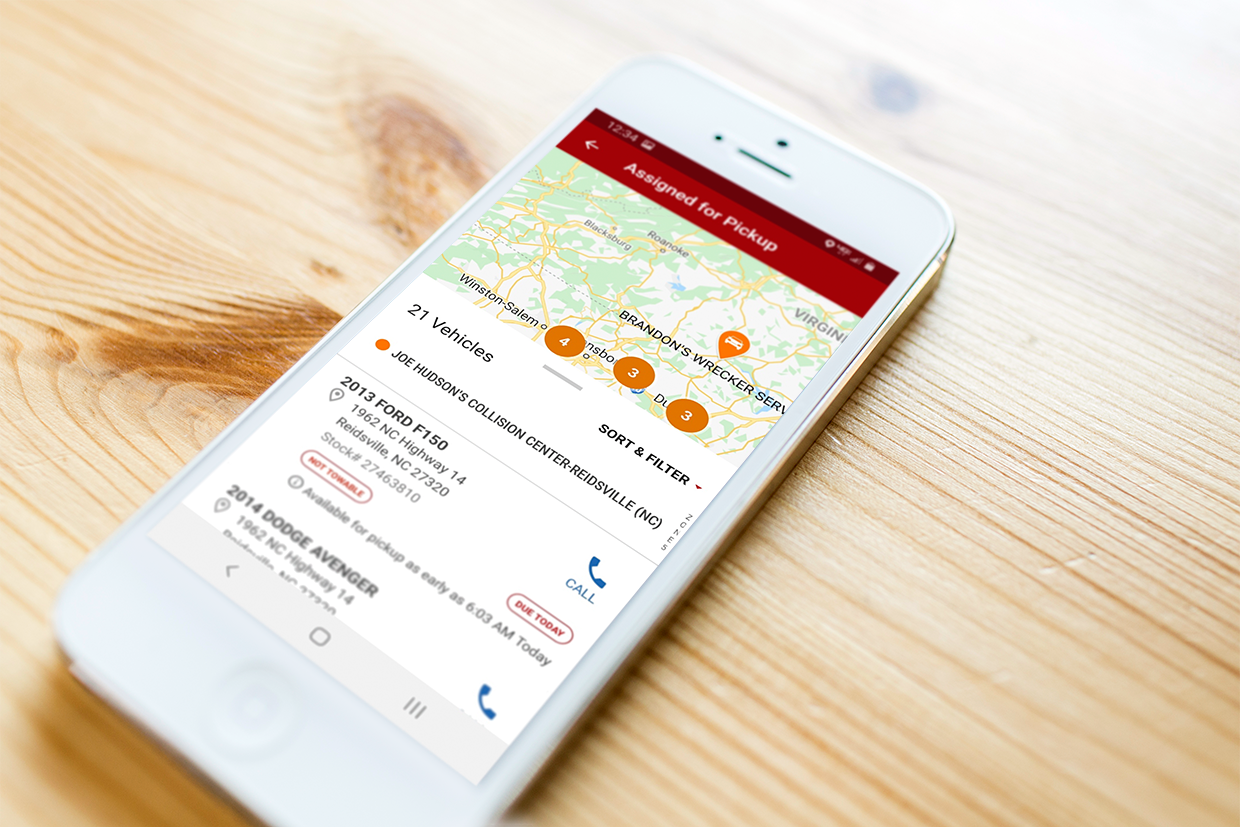
Auto Dispatch connects available towers to tow assignments, automatically. It makes working with IAA seamless for contracted towers eliminating paperwork requirements, and using technology to speed up the payment process.
Scalable Release Process Administration
IAA’s centralized contact center model, with redundant capability across multiple sites and work-from-home continuity, provides the advantage of scalable resources to process vehicles catastrophe assignments. Our contact center resources utilize structured labor management systems that deploy appropriate resources to handle volume spikes caused by catastrophes. When demand increases, our centralized contact centers can quickly scale This scalability accelerates the logistics process from assignment, to release, to dispatch and towing while driving increased policyholder satisfaction.

IAA Transportation Logistics | Competitive Advantages
- IAA has consistently delivered the industry’s leading catastrophe service and response in all events that have occurred since Hurricane Sandy in 2012.
- Industry-exclusive Auto Dispatch technology in IAA’s Tow App significantly shortens cycle times, and increases efficiencies for our insurance clients, their policyholders, and our towing industry partners.
- Scalable, centralized contact centers provide significant flexibility and resources to speed all transportation-related processes, including vehicle assignments, releases, dispatch and towing.
- Investment in resources to develop and maintain relationships within the towing industry provides the resources and flexibility to manage any sized catastrophic event.
- Focus on towing industry relationships provides the right level of resources in the right locations in both catastrophe situations as well as day-to-day operations.
- Transportation Logistics alone cannot manage a catastrophe. IAA’s Catastrophe Response Strategy consists of four components including Transportation Logistics, Operational Execution, Real Estate Capacity and Product Service Support – an unmatched portfolio of capabilities.
Forward-Looking Statements
Certain statements contained in this release contain forward-looking statements within the meaning of the Private Securities Litigation Reform Act of 1995 and which are subject to certain risks, trends and uncertainties. In particular, statements made in this release that are not historical facts may be forward-looking statements. Words such as “should,” “may,” “will,” “anticipates,” “expects,” “intends,” “plans,” “believes,” “seeks,” “estimates” and similar expressions identify forward- looking statements. Such statements include statements regarding the expected timing and associated benefits with respect to this catastrophe brief on our business and plans regarding our growth strategies and margin expansion plan, and to our customers and company generally. Such statements are based on management’s current expectations, are not guarantees of future performance and are subject to risks and uncertainties that could cause actual results to differ materially from the results projected, expressed or implied by these forward-looking statements. These risks and uncertainties include, but are not limited to: uncertainties regarding COVID-19, and other potential future health crises, including new more contagious and/or vaccine resistant variants, and the impact on the duration and severity of the COVID-19 pandemic and measures intended to reduce its spread, including the availability, rate of public acceptance and efficacy of COVID-19 vaccines; the loss of one or more significant vehicle suppliers or a reduction in significant volume from such suppliers; our ability to meet or exceed customers’ demand and expectations; significant current competition and the introduction of new competitors or other disruptive entrants in our industry; the risk that our facilities lack the capacity to accept additional vehicles and our ability to obtain land or renew/enter into new leases at commercially reasonable rates; our ability to effectively maintain or update information and technology systems; our ability to implement and maintain measures to protect against cyberattacks and comply with applicable privacy and data security requirements; risks associated with online commerce security and credit card fraud; our ability to successfully implement our business strategies or realize expected cost savings and revenue enhancements, including from our margin expansion plan; weather-related and other event beyond our control which may adversely impact operations; failure to attract and retain key personnel, have inadequate succession planning, or manage labor shortages; business development activities, including acquisitions and the integration of acquired businesses, and the risks that the anticipated benefits of any acquisitions may not be fully realized or take longer to realize than expected; our expansion into markets outside the U.S. and the operational, competitive and regulatory risks facing our non-U.S. based operations; our reliance on subhaulers and trucking fleet operations; changes in used-vehicle prices and the volume of damaged and total loss vehicles we purchase; economic conditions, including fuel prices, commodity prices, foreign exchange rates and interest rate fluctuations; trends in new- and used-vehicle sales and incentives; and other risks and uncertainties identified in our filings with the Securities and Exchange Commission (the “SEC”), including under Item 1A “Risk Factors” in our Annual Report on Form 10-K filed with the SEC on February 28, 2022, as such risk factors may be amended, supplemented or superseded from time to time by other reports we file with the SEC, including subsequent Quarterly Reports on Form 10-Q and Annual Reports on Form 10-K. Many of these risk factors are outside of our control, and as such, they involve risks which are not currently known that could cause actual results to differ materially from those discussed or implied herein. The forward-looking statements in this release are made as of the date on which they are made and we do not undertake to update our forward-looking statements.
